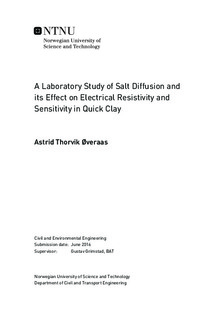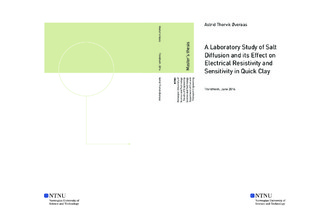| dc.description.abstract | Resistivity measurements as a geophysical method have become increasingly popular as a supplement to geotechnical field investigations over the last years. The main use for this method is to uncover the possibility of quick clay occurrences. Since low salt content indicates sensitive clay, resistivity profiles can give an image of potential quick clay deposits, as there is a strong relation between resistivity and salinity.
To get a greater grasp of the relation between salt and resistivity a laboratory experiment was invented by introducing a marine clay to a brine. The laboratory set-up consisted of three 54 mm cylinders that were coupled up to two tubes at each end, which worked as water reservoirs. One of the cylinders had tubes filled with water and the two others with different salt concentrations. Each cylinder had a number of electrodes, which were coupled up to a voltmeter and a power source. The change in voltage between the electrodes were measured for each cylinder at a chosen times throughout the experiment, which then was compared to the results from the other cylinders. By having many electrodes perforating the clay, the resistivity along intervals in the clay could be found. An exact set-up like this is not known to have been performed before, but the results are comparable to earlier studies concerning resistivity measurements in quick clay due to salt exposure.
An introduction to the physical properties of quick clay and the use of resistivity as a geophysical measuring method are necessary to understand the theory behind the experiment. The relation between quick clay and resistivity is defined by their characteristics. Quick clay is defined by its internal structure, the formation and physical properties according to defined standards. Further, the characterization of the resistivity is based on basic physical laws, and the relation to water, salinity and changes in temperature, porosity etc. A brief description of resistivity used in the field, are included.
It was performed index testing of one of the cylinders after 38 days to see how the salt had affected the clay. The cylinder was divided into 16 parts for index testing. The results from the cylinder indicated a strong relation between salt and resistivity and changes in the geotechnical parameters. As the clay was applied more salt, the resistivity decreased. It is noticed an increase in remoulded and undisturbed shear strength with increasing ion diffusion front. The plasticity limit was expected not to change, but there were found an increasing plasticity limit when the salt content was increased. This is thought to be due to the plasticity limit being found after retrieving the salt content, which was found after centrifuging the water and stirring it back into the clay. This could have altered the properties of the clay. The water content did not change noticeably, which coincided with earlier studies.
The average salt values for the samples at the bottom part of the clay cylinder were compared to the average length of the sample, which is considered to be the measured effective diffusion length. The measured and effective calculated diffusion length for the samples and its respectively salt content, shows that they correspond quite well, despite all simplifications made to be able to relate these values.
The trendline for the resistivity and salt, based on different clays in the earlier study by Long, is a bit higher than for the resistivity values retrieved from this experiment (Long et al., 2012). Some of the values does however correspond quite well, and any deviation may be caused by local variations or errors such as temperature, water content, clay content, porosity etc.
One can however conclude that the salt do decrease the resistivity, which with a high enough concentration front of approximately 0,5 g/L influence the clay in such a way that it is more suitable for construction purposes. The cost of such a procedure in the field is very high and also a very time-consuming proses (Helle, 2013). It will however be of interest to improve the ground conditions in many cases, such as in highly populated areas, mainly because the value of a secure and buildable ground may exceed the downside of the high costs related to the development. | |

